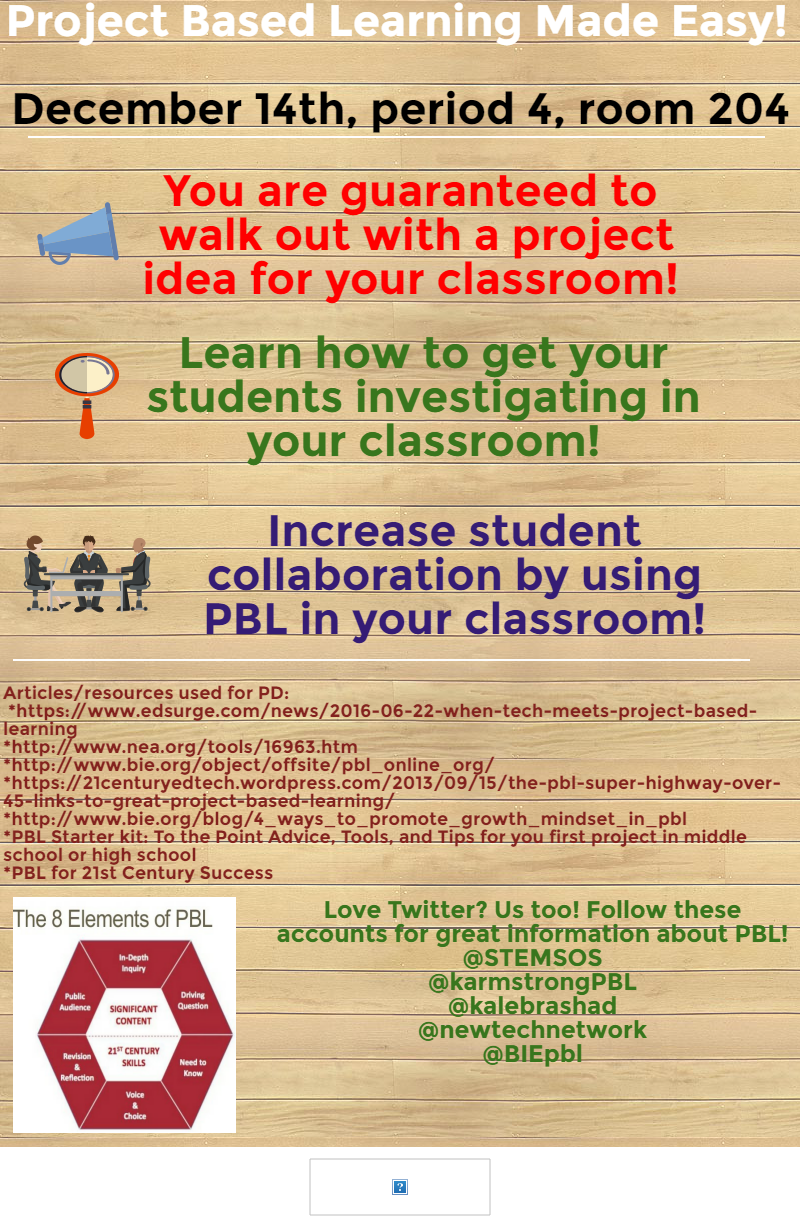Deep Play Group
What is “Deep Play”?
By deep-play we mean an engagement with rich problems of pedagogy, technology and content and their inter-relationships. Deep-play is creative, seeking to construct new ways of seeing the world, and new approaches to using technology, in order to develop creative pedagogical solutions.
– Taken from Deep-play: developing TPACK for 21st century teachers by Mishra & Koehler
By deep-play we mean an engagement with rich problems of pedagogy, technology and content and their inter-relationships. Deep-play is creative, seeking to construct new ways of seeing the world, and new approaches to using technology, in order to develop creative pedagogical solutions.
– Taken from Deep-play: developing TPACK for 21st century teachers by Mishra & Koehler
PD and Newsletter
This 2-hour professional development session and newsletter were created to introduce 20-30 participants to project-based learning, and provide them the knowledge, tools, and resources to try a project in their classroom. These materials were created by the deep play group, with my contributions in the outline.
|
Project Based Learning Made Easy
Format: Physical session Learning objectives: ●Participants will learn about the essential elements of effective project-based learning instruction, the research that supports its effectiveness, and common misconceptions. ●Participants will leave the session with a project idea for their classroom. ●Participants will be provided rubrics and templates to begin implementing project-based learning in their classroom. 1.Contrasting lessons a.Traditional interaction with 5th grade arithmetic. (10 min) b.Project based activity on same topic -- party planning activity (20 min) 2.PBL 101 a.Reseach buy-in re: PBL effectiveness (10 min)
3.Template hard copies (10 min) 4.Time to brainstorm, grouped by content (30 min) 5.Highlight favorite resources from the following list (10 min) Resources a.Books i.PBL Starter Kit ii.PBL in the Elementary Grades iii.PBL for 21st Century Success iv.PBL Starter kit: To the Point Advice, Tools, and Tips for you first project in middle school or high school v.Project-Based Learning Tasks for Common Core State Standards , Grades 6 - 8 vi.Project-Based Learning: Differentiating Instruction for the 21st Century vii.Project Based Learning: 25 Projects for 21st Century Learning b.Websites i.Research Spotlight on Project-Based Learning ii.PBL-online.org iii.4 Ways to Promote Growth Mindset in PBL iv.When Tech Meets Project-Based Learning v.The PBL Super Highway… Over 45 Links To Great Project Based Learning c.Twitters to follow i.STEMSOS Model @STEMSOS ii.Kevin Armstrong @karmstrongPBL iii.Kaleb Rashad @kalebrashad iv.@newtechnetwork v.@BIEpbl vi.@TCEA vii.Liam Bayer @liamBIE viii.Project Lead the Way @PLTWorg |
Book Hangout on Air
Tinker Tale: Take 2
Find the book I'm reading - Project Based Learning (PBL) Starter Kit
PBL: What Does It Take for a Project to Be "Authentic"?
3 Tips for Planning Authentic PBL Projects
Authentic Learning for Students Resources
PBL: What Does It Take for a Project to Be "Authentic"?
3 Tips for Planning Authentic PBL Projects
Authentic Learning for Students Resources

